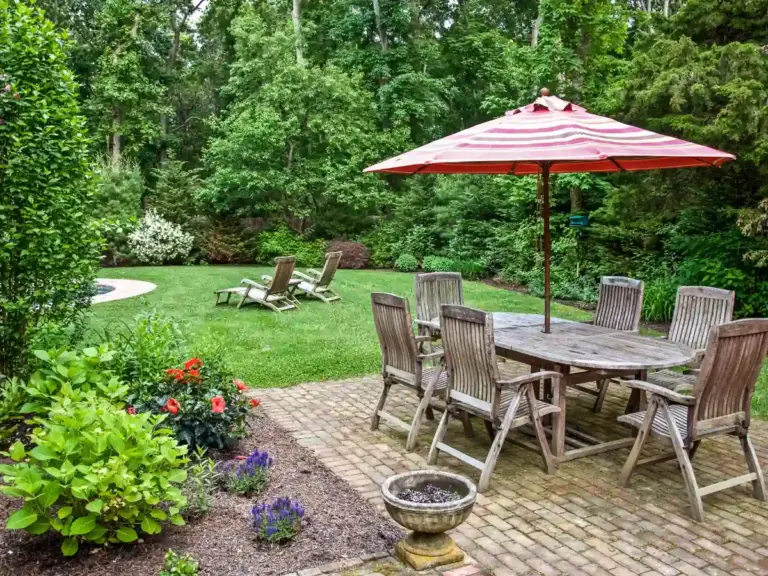Living Fences for Yard Privacy (Pros, Cons & How to Grow Them)
A living fence, also known as a live or natural fence, is a row of trees or shrubs that form a hedge along the perimeter of a property. Live fences are eco-friendly, versatile, and naturally beautiful. They’re, however, slow to develop, not intrusion-proof, and need frequent maintenance.
To grow a thriving living fence, you have to plant correctly, while also watering, mulching, and pruning as necessary.
What is a Natural fence?
A natural fence is made of trees or shrubs grown close together to form a living hedge or barrier. Evergreen trees with dense foliage provide the best privacy for natural fences. It’s hard to see through the broad leaves. What’s more, the leaves won’t fall off during the cooler seasons, thus providing year-round privacy around your home.
Pros of Live Fence
Here’s the advantages of having natural-live fence in your yard for privacy:
Are an Eco-Friendly Fencing Option
Living fences are an environmentally friendly fencing option. Manufactured fences, including steel (barbed wire), wrought iron, aluminum, and vinyl fences are non-biodegradable; while twigs and leaves that fall off of live fences break down quickly.
Installing a natural fence also boosts ecological diversity within your yard. Different animal species can make a home out of shrubbery fencing, thus providing ecological balance.
Are Versatile
Trees and shrubs are versatile fencing options as you can mix different types of plants, or even combine them with commercial fencing. For instance, climbing vines add a natural touch to concrete wall fences, while shrubs with dense foliage add much-needed privacy to chain link/barbed wire fencing.
Enhance Curb Appeal
Living fences also enhance your curb appeal by adding a touch of natural beauty. Deciduous hedge plants will spot red, yellow, and orange foliage during winter; forming a beautiful, multicolored living fence. Meanwhile, if you prefer lush green, natural landscape aesthetic along the perimeter of your compound, go for evergreen privacy trees.
Are a Source of Food, Medicine, and Timber
Since living fences can be developed from different types of shrubs and trees, they also double up as a great source of various resources like food, timber, and medicine. Living fence species like some types of cacti, cumquats, and pomegranates produce sweet-tasting fruits. Meanwhile, taller, woody varieties are great sources of timber.
Cons of Live Fence
Here’s disadvantages of having a living fence in your yard for privacy:
Not a quick Solution
If you’re looking for a quick solution to your home’s privacy and security needs, a natural tree fence isn’t the best option. It takes time for young trees and shrubs to grow into a thick, beautiful hedge. It may take several months or years to fully develop your natural fence, depending on the type of shrubs or trees that you’re growing as a hedge.
Needs regular Maintenance
A common problem with using trees as fencing is that they want to grow and spread as far and as wide as possible. As such, you’ll have to prune your hedge fencing frequently to keep it looking neat.
May Starve your Yard/Garden Plants
If your fence plants grow extensive root systems, they’re likely to compete for soil nutrient and water resources with your yard or garden plants, essentially starving them. What’s more, some hedge trees grow tall and form wide canopies, thus preventing smaller plants within your yard from receiving enough sunlight.
Not great for Security
If your goal is to keep off intruding humans and animals, a live fence isn’t your best option. However, you can fix this issue by planting thorny shrubs that humans and animals can’t easily maneuver past. Another alternative is to combine your shrubbery hedge with barbed wire fencing.
Note: To prevent your living fence from starving out your yard plants, pick hedge plant species with non-invasive roots.
How to grow live fence on yard for privacy
To be able to grow a natural fence for privacy, it will take patience and caring for it. First, select the best shrub or trees for the fence when planning how to grow it and where to plant.
Here’s a step by step guide on how to grow live fence for yard privacy
1. Pick the right type of Shrub
When picking which plants to grow as your living fence, consider what your objectives are. Looking for better security? Pick a thorny shrub. Looking for more privacy? Go for tall-growing hedge plants. In need of something that’s relatively low-maintenance? Then go for plants that don’t need regular pruning.
2. Mark out the Area
Whether you want a straight or curved hedge, demarcate the area with two lines to provide a visual outline. The distance between the two lines should be about the same size as the diameter of the root ball of your chosen hedge plant species. You can use chalk, spray paint, or spaced-out sticks for this step.
3. Clear the Demarcated Area
If there are any other shrubs or weeds growing within the demarcated area for your new live fence, uproot them by hand or with a weed digging tool. This protects the hedge plants from having to compete for available water and nutrients in the soil.
4. Dig out Planting Holes
Next, dig out holes where you’ll bury the seeds or the root ball/stalk of your seedlings or plant cuttings. For seeds, two-inch deep holes will do. Meanwhile, for seedlings, each hole should be deep enough to accommodate the entire root ball.
5. Plant the Seeds or Seedlings
With the holes already dugout, it’s now time to plant your living fence. To properly sow seeds, bury them inside the holes by completely covering them with soil. As for seedlings, root sprouts, and stem cuttings, you want to bury only the root ball or lower part of the stalk into the hole.
6. Water the Live Fence
After planting your live fence, water the seedlings/seeds deeply. Generally, plants need more water during the first growing season and should thus be irrigated more often at this stage. However, different hedge plant species have different water requirements, so research about your species’ hydration needs to avoid overwatering/underwatering it.
7. Mulch your Hedge
Add a 3-inch layer of organic mulch at the base of the growing hedge plants to improve moisture retention and to enhance soil organic matter. Shredded wood mulch or compost mulch will work just fine.
8. Prune the Hedge
As your living fence grows, you should regularly trim the plant foliage to encourage dense growth. Clipping off the taller branches encourages lateral growth, resulting in a bushier hedge that offers more privacy and is more visually appealing. When trimming your live fence, use a sterilized pair of pruning shears to avoid introducing bacterial infections and to make cleaner cuts that will heal faster.
5 Best live fences for yard
Some of the best living fences for yards include junipers, oleanders, Japanese Euonymus, Korean Lilac, and arborvitae.
1. Juniper
Juniper is a popular hedge plant due to its eye-catching foliage. It’s also an evergreen conifer, which means that you’ll get to enjoy a green screen all year round. Junipers are also drought-hardy and can grow even in sandy soil conditions.
Junipers will also thrive in soil that’s mildly acidic or mildly alkaline. This conifer species also thrive in sunny conditions but is also tolerant of partial shade.
You can prune your juniper live fence into artsy shapes, and since they’re slow growers, they’ll maintain the artistic trim design for longer. Due to the plant’s slow growth rate, you should avoid pruning your junipers too often. They also don’t like excessively wet soil conditions.
2. Oleander
Oleanders have dense-growing foliage, making them great privacy plants for living fences. It’s red-pink flowers are also fragrant and add ornamental allure to your yard. Oleanders are also low-maintenance hedge plants, as they’re drought-hardy and can withstand wind and heat.
One major downside to using oleanders as a living fence, though, is that they only grow up to eight feet tall, making them unsuitable as a privacy hedge if you need a taller yard barrier. Oleanders are also slow growers and the plant parts are also toxic if consumed.
3. Japanese Euonymus
If you’re not too patient and want to plant a living fence that will grow up fast, consider going for Japanese Euonymus, botanically known as Euonymus Japonicus. This fast grower can grow up to 15-feet tall, providing excellent privacy if you have high windows. However, if you prefer a shorter but denser hedge, you can prune back the plant’s foliage.
Japanese Euonymus also adds ornamental appeal to your living fence with its variegated leaves and greenish-white blooms. This hedge plant species thrives in partial shade and damp, well-draining soil.
4. Korean Lilac
If you want a living fence that will significantly boost your yard’s ornamental appeal, go for Korean Lilac. This popular hedge plant produces fragrant purple blooms in spring. It also grows low, only up to eight feet tall, making it a great option if you want a low hedge.
Korean lilac is also resistant to powdery mildew, a common fungal disease amongst ornamental plants. One disadvantage of Korean Lilac, though, is that it’s a deciduous plant, thus won’t stay green all year long.
5. Arbovitae
If you fancy a very tall edge that offers utmost privacy, then arborvitae is your hedge plant. This plant species can grow up to 40 feet tall.
Arborvitae thrives in sunny conditions and well-draining soil. Choose your arborvitae species carefully though, as some varieties grow narrow, thus won’t form a dense hedge that offers maximum privacy.
References
- Karen Russ and Bob Polomski, Clemson University: Oleander plant varieties


